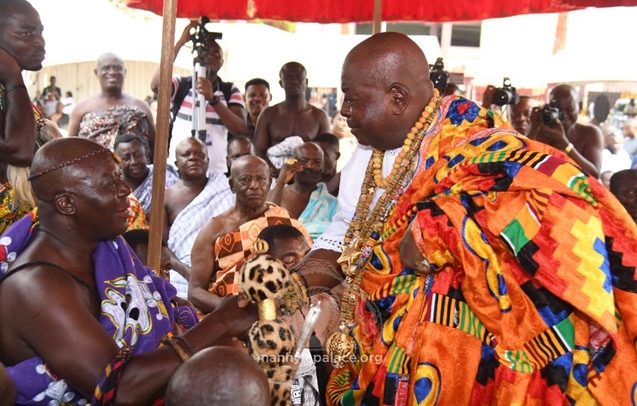Celebrating The Ewe Asante Romance (1)
THE PAST weekend had many sides and allowed you to exercise your preference as to whether to laugh or cry. If you wanted to laugh you could tune in to a Kume Preko demonstration, which raised very high hopes for the hungry man, and ended up as a Sere Me Preko.
In the near future, I will do a humble anatomy of demonstrations and undertake a clinical surgery, perhaps with the help of my good friend Professor Cliff Tagoe, who is a clinical anatomist.
Thereafter, we shall invite Professor A. B. Akosa, the great pathologist, to undertake an autopsy. Nana Akosa, please stand by for this important national assignment.
There was also a lot to wail about. Our friend A. B. Crentsil, a legendary highlife musician, had passed on to eternity, and it was time to take him home. The tearful scenes witnessed on TV were humbling. May A. B. rest in peace.
But there was something to cheer about within the context of national gloom, stress, strikes, and even anger in places: a festive occasion, that brought hope, hummed peace and sang a chorus of unity, harmony and national cohesion.
The architects of the festival were Awomefia Torgbui Sri III, Paramount Chief of the traditional Anlo State, partnered by several great chiefs and kings from around the country. In attendance was the Vice President, Dr. Mahmoud Bawumia, standing in for the President.
It was the 60th Hogbetsotso festival of the Anlo people.
But I single out for mention the historic participation of Otumfuo Osei Tutu II, King of the traditional Asante state, who made history as the first Asantehene in more than a century, to set foot on the sandy landscape of Anloga, and break bread with the Anlo people. It was simply historic.
For those unsure of the importance of Otumfuo’s attendance, let me offer a few reminders for the record. Otumfuo Osei Tutu II, in September this year, turned a blind eye to the funeral of Queen Elizabeth II, in which several global dignitaries stampeded to participate, and others considered as lifetime camera opportunities.
Recall the meandering queue of several kilometres of mourners, slowly moving day and night to file past the royal remains at Westminster Hall, London.
But also remember the humbling of some dignitaries who lost their ceremonial sovereignty, and were treated to bus rides, while their subjects giggled back home calling it a humiliation.
For chiefs and kings that attended the event in London, some may have quietly broken local taboos and for the first time, set eyes on mortal remains while occupying royal positions.
Not Otumfuo Osei Tutu II. He decided to opt-out of the madding crowd, diplomatically declining an invitation to attend. Let the dead bury their dead, he said under his breath.
His forefather, Osei Tutu I, had paved the way, founding the Asante empire in the 18th century. Not until 1900, the Asante resisted joining the Queen’s Gold Coast Colony, and it took the exiling of a ‘stubborn’ King Prempeh I by the British, to pave the way for colonisation.
In 1902, after exiling King Prempeh, the British routed the Asante and looted their treasury. These are sour historical points to note and pass on, and not suppress in the name of contemporary diplomacy.
Above all, Asante custom itself forbids Otumfuo from setting eyes on mortal remains.
Simply, Asantehene does not join crowds; he throbs with a sense of history and custom and steps forward only with the discretion of hindsight.
There is homework to do in our own homeland, he said to himself.
Otumfuo leads a traditional state that is very hospitable to other cultures; it adopts and adapts fragments of other lifestyles, and so does it leave residues of its own in areas of mutual interaction.
To this end, there is an entire township of Ewes in Kumasi, Anloga, which is well recognised and integrated; and there has been a sprawling ‘Pekyi’ settlement, for immigrants from Peki, from time immemorial.
Diversity does not impoverish Asante culture, it enriches Asante. On ascending the throne in 1999, Otumfuo Osei Tutu II established an Education Fund and extended this to all needy but brilliant students regardless of ethnicity. But one thing must have hurt Otumfuo’s pride: the deep-rooted mistrust between the Asante and Ewe, that still permeates all sectors of life.
If there were any historical alliances between the two, these may have been erased by a single incident triggered by the politics of 20th century Ghana. And what was this?
In 1969, one Asante politician, venerable lawyer Victor Owusu, during his campaign for the general elections, made a derogatory reference to Ewes at Ho.
He belonged to an antecedent of the NPP called the Progress Party (PP), led by Dr. K. A. Busia, who was battling the National Alliance of Liberals led by K. A. Gbedemah.
The ethnic slur was clearly in bad taste, and for these, copious apologies were rendered and rituals of atonement performed.



